Return to Monkey Island review - buried treasure
Deep in the Caribbean...
My favourite Monkey Island story isn't about a puzzle or a character or a joke. It's not Stan and his hand-talking, or the severed head that can lead you through mazes. It's not actually a story from the game itself. It's to do with a friend of my wife's. This friend once admitted that, as a kid, whenever she had a story she wanted to tell her mum, her mum would always stop her at the start and say, with what I'm guessing was a heavy, deeply theatrical sigh, "Is this about Monkey Island?"
I think about this a lot. A kid who was so in love with Monkey Island, who spoke about it with such granularity and such endless passion, that it made their mum grow wary of every fresh conversation. To this day whenever I'm particularly boring my wife will stop me and say, "Is this about Monkey Island?" Conversation ended. Conversation defeated.
And of course the funny thing is, if there was ever a game worth talking about it's Monkey Island. Let me clarify: loads of games are worth talking about, but Monkey Island - the first one - is singular in how much it's worth telling people about. Things happened in that game that felt unprecedented back in the early 1990s. The scope of it, the richness of the Caribbean setting, the ease of the comedic tone. But also the set-pieces. The fact that the fourth wall was acknowledged and then shattered. As school kids playing this game in the evenings and weekends, game characters who were almost aware they were game characters - who were made to say things that they realised they hadn't chosen to say? Well, this felt almost illicit. Maths room, 9am on a Monday: You will not believe what happened in Monkey Island last night.
Monkey Island, incidentally, was an adventure game or point-and-click that lead to a series of adventure games. You know the deal: collect items, engage in conversations, and solve problems by using A with B. Move on. Upwards, outwards. Back in the day this was the single most lavish genre around - it was a sumptuous genre. How many different locations? How many characters? How many puzzles? How many dialogue choices? This was the genre that developers poured everything they had into. The basics were set - use A with B - but so much else was constantly being reworked between games. Vital genre territory was up for grabs. Should you be able to die in an adventure game? Should you have programming puzzles? How stuck should a player be able to get for it to still count as, like, gameplay?
Monkey Island ruled here. Eight blue disks, if memory serves, and a code wheel to get past the copy protection each time. And you loaded it up and you were off to the best video game world imaginable: the Caribbean in the days of pirates, sure, but also some of those pirates are zombies! And there are jokes! Everybody's funny!
Oh the jokes. Jokes that turned swordfighting into a game of matching insults, which meant it worked as a mechanic and was also hilarious. Jokes that hid puzzles within them: what to do with that red herring in your inventory? Jokes that had clearly been made by real people with their own cultural lives and touchstones. Most of all, jokes that made you realise that adventure games were stupid really, riddled with abrupt limitations and contradictions, but jokes that also made you realise in turn that it was the stupidity of the genre that made it brilliant. Monkey Island was phenomenal.
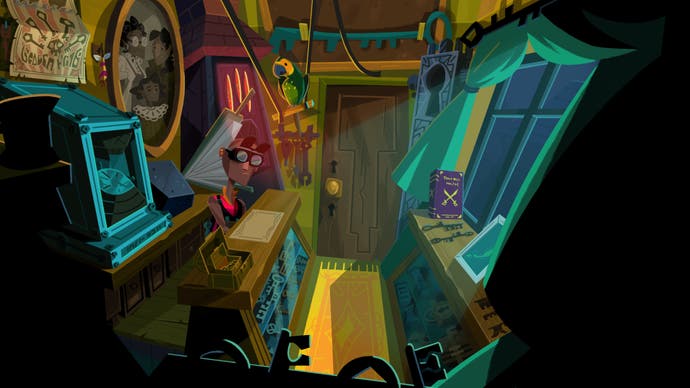
The sequels were good, too, to a point. I even like the third one, which was clearly the work of a slightly different team, but offered a brisk story and great puzzles while skilfully navigating the nostalgia the series was already trailing behind. I was at university when the third game came out - it was the self-reflexive era, the Scream era, with movies about movies filled with dialogue about dialogue. The third Monkey Island finishes with a theme park ride that tells the stories of the first two games, and is also a decent puzzle at the same time. Baudrillard would have been moved to an essay or two if he played it. I almost wet myself.
Now, Monkey Island has returned. Return to Monkey Island! Another old school adventure game about using A with B, with the team of Ron Gilbert and Dave Grossman back in charge. (Tim Schafer is away sadly, but he's busy so who can blame him?) A proper homecoming! And guess what, it's a thing of immense charm. A thing of luxurious, quilted, velveteen nostalgia.
I appreciate I have made the pivot to the new game rather late here - even by my wonky standards. The thing is, though, I could probably argue that this is thematic, even harmonious. Because Return to Monkey Island is deeply, deeply in love with the first Monkey Island, The Secret of Monkey Island. In love with it, in thrall to it, in step with its famous beats and itinerary. It deviates, sure, and adds its own glorious new additions to the series, including at least one great new character and a handful of glittering new islands, none of which I will spoil. But from the off it feels like a succession of cherished trinkets dropped into the kind of magical voodoo cooking pot that turns up so often in these games. A spell is being worked. Spiritual successor? The spirit part is right. This is almost an attempt to summon the bright ghosts of the past.

I will honestly try to spoil nothing but the basics. Guybrush Threepwood, the Judge Rheinhold pirate wannabe, is back and eager to really crack the secret of Monkey Island this time. He returns to Melee Island, the series' best location. It's night. The lookout is still blind. Guybrush is still after a ship and a crew and - to be honest - a bit of a plan. He knows what he wants: treasure. But he doesn't know how to get it. And so you set off.
A word on the interface. This is experience! It's fascinating to play the Monkey Island games in sequence and see how adventure game interfaces evolved. Verb lists? Verb lists with pictorial inventories? A sort of magical doubloon attached to your cursor? Return is the kind of simplicity that comes from time and understanding. A pointer you move around the screen, a selection of clearly marked interactive elements you can basically tab between, and an inventory that allows you to select an object and place it with anything you want to combine it with. Contextual button prompts tell you what you can and can't do, dialogue can be skipped or repeated. It's a game that wants to get out of your way as much as possible.
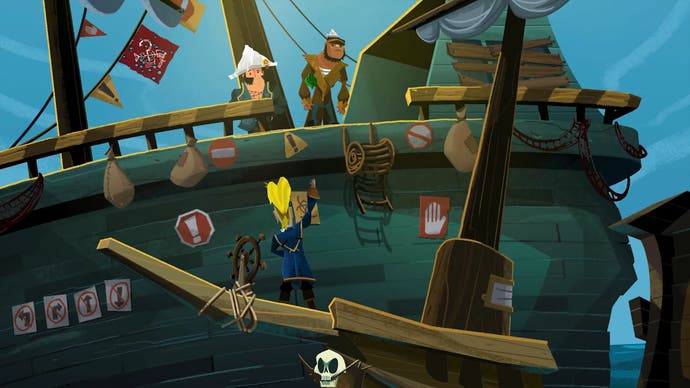
And with the interface out of your way, it's Melee Island as you always remembered it, right down to the layout of the streets and the way the screens fit together. If you knew how to get to the Governor's Mansion back in 1992, you can still get there today. And so the great superpositioning begins: memories of the old games laid upon the landscape of the game you are now playing, or maybe vice versa. Memories mingling with the present.
No spoilers. The puzzles are good. I like the way they work - they often come down to combine A with B - but I love the way they are mounted and contextualised. Via the medium of A with B, you make friends, savage the environment, upend traditions and ruin lives. You win enemies over, make enemies of people who trusted you, and revel in the glorious adventure of being a pirate who is also kind of an idiot.
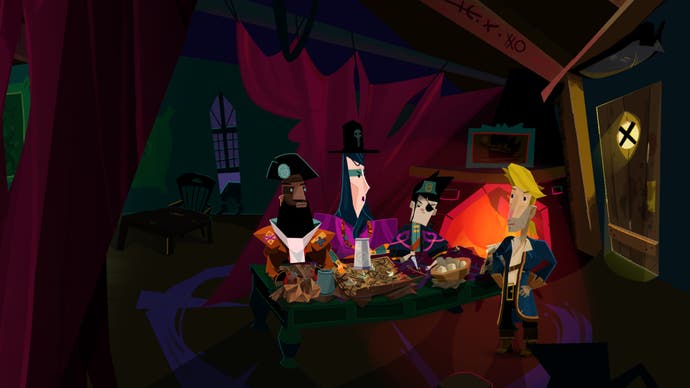
And the A with B is always clever, often hinging on the perverse or unlikely use of an object in a specific situation. You look at your inventory and think, what is this item, but also what might it accidentally be used for? Dorothy Parker spoke of the disciplined eye and the wild mind: it's a combination that suggests she would have been pretty good at Monkey Island.
The narrative takes a while to reveal itself. I can at least say it walks a fine line in terms of giving you warmly familiar things to do and places to visit, before opening things out and taking you places that feel new but also of a piece. When the game really opens up, there can be quite a bit of backtracking, but even this is rendered simple by a button that takes you immediately back to the map screen. This is a game born of frustrations with adventure games. The challenge remains, but the friction has been taken away.
(On this front: marvel at the hint system, which can take you through the entire game if you want it to. Not only does it offer staggered hints which provide a series of nudges before giving the complete solution, it's also contextual - it's able to track where you've been and what you have, so it can tailor its advice perfectly. What a thing it is!)
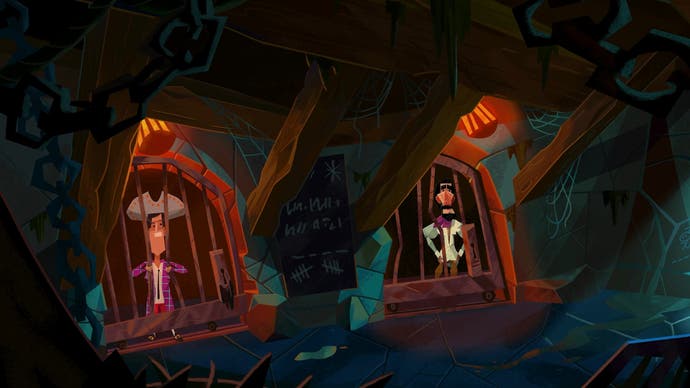
Changes? Rex Crowle's art offers a fresh approach to the series, but for me it suited the game and its history perfectly. We're in a world of textured flatness here, if such a thing is possible. Backdrops are stage-setting thin but gloriously detailed, and the overall mood is both dark and haunted, as if Mary Blair had been around when Disney was making Pinnochio. Crowle loves angular zig zag shapes - a crevice in the ground, a splintered tree, a rock path across lava - and often builds an entire location around them. And in amongst the canted angles and halloween pumpkin glow emanating from every window, there are great surges of imagination: LeChuck's ship has a stern covered with vents that give way to a hellish red, as if Satan is handling propulsion personally. A forest at night is angular foliage jangling against pure shadow: you never know where the ground drops away or what creatures might lurk out of sight.
Character art is unsettling in close-up - button eyes, scribbled hair, bristles and shapes like mid-life bars of soap - but they're a reminder that Monkey Island character art was always unsettling. Do you remember your first conversations in the Scumm bar, where the punch-and-judy in-game models suddenly gave way to the stark, lurid realism of the close-ups? It always gave me a shiver, just as the carefully sketchy, abstracted scribbles of Return's art do. Take Crowle's Guybrush himself: stubble; wild hair; a touch, somehow, of Bono. It's far weirder than the sitcom warmth of Dominic Armato's voiceover. But that's the point. In the juxtaposition it creates something interesting. And it was ever thus, in its way.
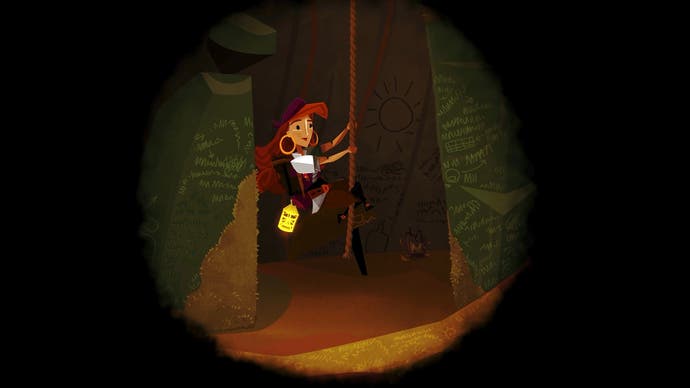
What Return is occasionally missing is the audacious hilarity of set-pieces like the gopher horde sequence from the first Monkey Island, which was played out of sight of the player behind a wall, and with all the action unfolding using automated interface prompts to suggest a disaster that got wilder and wilder, that cascaded until the game could barely contain it. What's missing, in other words, is the impish spirit of the earlier game that often seemed to strain against the boundaries of the genre itself.
But the genre was young back then, and straining against it was perhaps a more fruitful thing to do. Return to Monkey Island is happier just to celebrate what it is - and it's hard to fault it for that. It's generous and it wants old fans to feel comfortable and appreciated - and pleasantly challenged.
Reader: it works. There are moments of nostalgia here that properly moved me, and one towards the end which made me want to phone a schoolfriend I hadn't spoken to in thirty years just to tell them about it. The office, 9am on a Monday, the switchboard puts through a name you can only dimly remember: You will not believe what happened in Monkey Island last night.









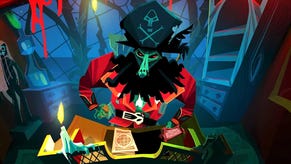
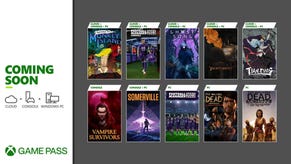
.png?width=291&height=164&fit=crop&quality=80&format=jpg&auto=webp)